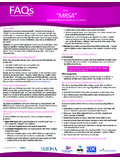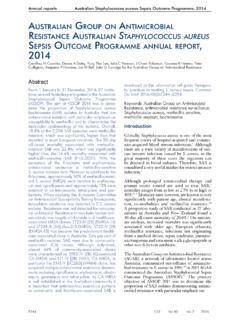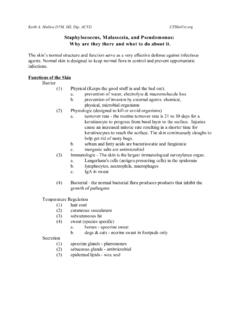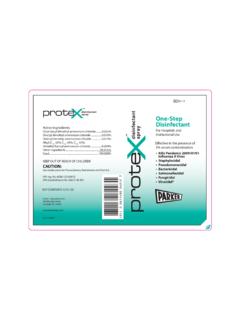Transcription of Methicillin-Resistant Staphylococcus aureus
1 Methicillin-Resistant Staphylococcus aureus (MRSA) InfectionsActivity C: ELC Prevention CollaborativesDraft 1/19/10 ----Disclaimer: The findings and conclusions in this presentation are those of the authors and do not necessarily represent the official position of the Centers for Disease Control and Jernigan, MD, MS Alex Kallen, MD, MPHD ivision of Healthcare Quality PromotionCenters for Disease Control and PreventionOutline Background Impact HHS Prevention Targets Pathogenesis Epidemiology Prevention Strategies Core Supplemental Measurement Process Outcome Tools for Implementation/Resources/ReferencesBackg round: Impact Staphylococcus aureusis a common cause of healthcare-associated infections Second most common overall cause of healthcare-associated infections reported to the National Healthcare Safety Network (NHSN) Coagulase-negative staphylococci (15%), S. aureus (14%) Most common cause of surgical site infections( 30%) and ventilator associated pneumonia (24%) methicillin -resistance in S.
2 Aureuswas first identified in the 1960s primarily among hospitalized patients Since that time, Methicillin-Resistant S. aureus (MRSA) has become a predominant cause of S. aureusinfections in both healthcare and community settings Primarily due to transmission of relatively few ancestral clones rather than the de novo development of methicillin -resistance among susceptible strainsHidron et al. Infect Control Hosp Epidemiol 2008;29:996-10 11 Background: Impact Current estimates suggest that 49-65% of healthcare-associated S. aureusinfections reported to NHSN are caused by Methicillin-Resistant strains National population-based estimates of invasive MRSA infections 94,360 invasive MRSA infections annually in the US Associated 18,650 deaths each year 86% of all invasive MRSA infections are healthcare-associatedHidron et al. Infect Control Hosp Epidemiol 2008;29:996-10 11 Klevens et al. JAMA 2007;298:1763-71 Background: ImpactWhy the Emergence of MRSA is a Healthcare Pathogen is Important (1) MRSA has emerged as one of the predominant pathogens in healthcare-associated infections Treatment options for MRSA are limited and less effective than options available for susceptible S.
3 Aureusinfections and result in higher morbidity and mortality High prevalence influences unfavorable antibiotic prescribing, which contributes to further spread of resistance prevalent MRSA more vancomycin use more vancomycin resistance (VRE and VRSA) more linezolid/daptomycin use more resistance Background: ImpactWhy the Emergence of MRSA is a Healthcare Pathogen is Important (2) MRSA adds to overall S. aureusinfection burden Preventing MRSA infections reduces overall burden of S. aureusinfections MRSA is a marker for ability to contain transmission of important pathogens in the healthcare setting Programs that successfully prevent MRSA transmission are likely to have benefit when applied to other epidemiologically important healthcare pathogens that spread by patient-to-patient transmissionBackground:HHS Prevention Targets Population-based surveillance 50% reduction in incidence rate of all healthcare-associated invasive MRSA infections National Healthcare Safety Network 50% reduction in incidence rate of hospital-onset MRSA bacteremiaHHS Action Plan to Prevent HAI( )Background: Pathogenesis For MRSA, colonization generally precedes infection In addition, colonization can be long-lasting --months or years in some subpopulations In general, MRSA is transmitted person to person; the de novo generation of resistance in S.
4 Aureusis very rare Transmission of MRSA from the environment to people, although it can occur, is less common than transmission from person to personBackground: Epidemiology Once acquired, MRSA colonization can be long-lasting --months or years in some subpopulations A patient acquiring MRSA colonization during a hospital stay has increased risk for MRSA infections following discharge, or during subsequent acute and long-term care admissions MRSA carriers also serve as reservoirs for further transmission as they move through and across healthcare facilities Healthcare facilities that share patients are interdependent upon one another with regard to their MRSA experience The quality of MRSA control in one facility may influence the MRSA experience in others There may be advantages to coordinated multicenter control programs involving facilities that share patients with one anotherBackground: Epidemiology Successful MRSA prevention is possible Single and multi-center studies have demonstrated that MRSA prevention programs can be effective Reductions in incidence of MRSA disease by up to 70% have been documented in acute-care facilities Significant intervention-associated reductions in the proportion of S.
5 Aureusinfections caused by MRSA have also been documented in these studiesEllingson K et al. Presented at SHEA 2009, Abstract et al. Clin Infect Dis 2006; 43:971-88. Robicsek et al. Ann Intern Med 2008; 148 Successful MRSA prevention is possible According to NSHN data, rates of central line-associated BSI (CLABSI) caused by MRSA have declined by nearly 50% in the past decade This observation may be primarily attributable to successful CLABSI prevention efforts The proportion of all S. aureus CLABSI caused by MRSA has continued to increase during the same time period Population-based estimates suggest the incidence of invasive healthcare-associated MRSA disease decreased by 11-17% in the US between 2005-2007 Burton et al. JAMA 2009; 301:727-36 KallenAJ, Strategies Core Strategies High levels of scientific evidence Demonstrated feasibility Supplemental Strategies Some scientific evidence Variable levels of feasibility*The Collaborative should at a minimum include core prevention strategies.
6 Supplemental prevention strategies also may be used. Hospitals should not be excluded from participation if they already have ongoing interventions using supplemental prevention strategies. Project coordinators should carefully track which prevention strategies are being used by participating Strategies:Basic Rationale Because MRSA colonization generally precedes infection with this organism, MRSA interventions primarily have targeted two broad areas: Preventing transmission from colonized to uncolonized persons a focus of most of the interventions in this toolkit Preventing infection in colonized individuals: Not MRSA-specific: Strategies aimed at preventing device and procedure-associated infections ( , ventilator associated pneumonias, central line associated bloodstream infections, etc), not necessarily MRSA-specific MRSA-specific: MRSA decolonization strategies Core Prevention Strategies Assessing hand hygiene practices Implementing Contact Precautions Recognizing previously colonized patients Rapidly reporting MRSA lab results Providing MRSA education for healthcare providersCore Prevention Strategies.
7 Hand Hygiene Hand hygiene should be a cornerstone of prevention efforts Prevents transmission of pathogens via hands of healthcare personnel As part of a hand hygiene intervention, consider: Ensuring easy access to soap and water/alcohol-based hand gels Education for healthcare personnel and patients Observation of practices - particularly around high-risk procedures (before and after contact with colonized or infected patients) Feedback Just in time feedback if failure to perform hand hygiene observedCore Prevention Strategies:Contact Precautions Involves use of gown and gloves for patient care Don equipment prior to room entry Remove prior to room exit Single room (preferred) or cohorting for MRSA colonized/infected patients Use of dedicated non-essential items may help decrease transmission due to contact with these fomites Blood pressure cuffs Stethoscopes IV poles and pumpsCore Prevention Strategies:Recognizing Previously Colonized Patients can be colonized with MRSA for months There is no single best strategy for discontinuation of isolation precautions for MRSA patients Being able to recognize previously colonized or infected patients who have not met criteria for discontinuing isolation allows them to be subject to interventions in a timely fashionCore Prevention Strategies:Laboratory Reporting Facilities should have a mechanism for rapidly communicating positive MRSA results from laboratory to clinical area Allows for rapid institution of interventions on newly identified MRSA patientsCore Prevention Strategies: Education To improve adherence to hand hygiene To improve adherence to interventions ( , Contact Precautions) Encourage behavioral change through a better understanding of the problemCore Prevention Strategies.
8 Device and Procedure-Associated Prevention Measures In addition to measures designed to prevent MRSA transmission, healthcare facilities should routinely implement strategies for preventing device-and procedure-associated infections Central line-associated bloodstream infections Surgical site infections Catheter-associated urinary tract infections Ventilator-associated pneumoniaSupplemental Prevention Strategies Active surveillance testing screening of patients to detect colonization even if no evidence of infection Widely used and even recommended as a core prevention strategy by some, but precise role remains controversial Other novel strategies Decolonization Chlorhexidine bathingSupplemental Prevention Strategies: Active Surveillance Testing (AST) When clinical culture results alone are used to identify MRSA carriers, more than half of all MRSA-colonized patients remain unrecognized* The rationale for active surveillance testing is to identify all colonized patients so that additional precautions can be applied ( Contact Precautions) To date, results of studies evaluating AST have had mixed results Huang et al.
9 Clin Infect Dis 2006; 43:971-978 Observational study Found largest decrease in MRSA bacteremia associated with institution of active surveillance Robicsek et al. Ann Intern Med 2008; 148:409-418 Observational study Found significant decrease in MRSA disease with universal institution of AST combined with decolonization regimens Harbarth et al. JAMA 2008; 299:1149-1157 Observational study No significant decrease in MRSA disease with institution of rapidAST Several successful MRSA prevention collaboratives have used AST as one of their interventions*Salgado CD, Farr BM. Infect Control Hosp Epidemiol 2006; 27:116-121. Supplemental Prevention Strategies: Active Surveillance Testing (2)Testing methods: Culture Pros Generally less costly A common practice most labs are used to Cons May take 72 hours to identify MRSA colonized patients. If pre-emptive isolation not employed, may allow for transmission prior to recognizing patient as positive Polymerase chain reaction Pros Rapid results Cons Expensive Technically more challengingSupplemental Prevention Strategies:Active Surveillance Testing (3)Unknowns: Which body sites should be tested?
10 Nares most common Other potential sites include wounds, axillae, groin Adding more sites increases yield of testing; contribution to goal of decreasing transmission unclear Frequency of testing? Generally done at time of admission, sometimes repeated weekly Including discharge AST allows for identification of transmission events that occurred during hospitalization Who should be tested? One commonly employed strategy: focusing on patients in high-risk areas ( , ICUs) Some employ facility-wide ASTS upplemental Prevention Strategies: Decolonization Therapy for MRSA Carriers Decolonization is use of topical and/or systemic agents to suppress or eliminate colonization May reduce risk of subsequent infections in MRSA carriers May help decrease MRSA spread by reducing reservoir of transmission No data yet to definitively support its routine use in general patient care settings Robicsek and Harbarth studies used decolonization in addition to AST with mixed results Growing evidence suggests that pre-operative S.














